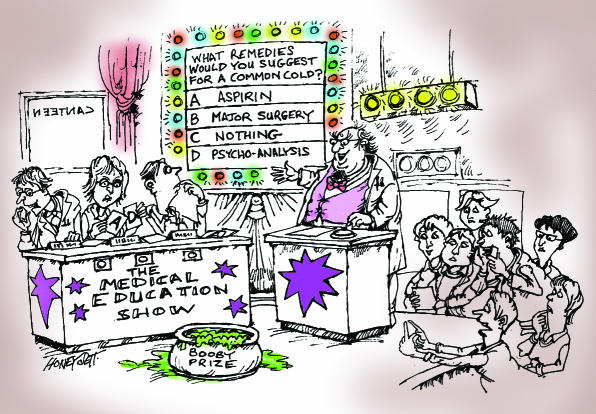Can medical education benefit from “lightening up”? Two Australian health professionals have turned education sessions into lively quiz shows
Today's challenge to medical educators is to provide continuing education that supports excellence in clinical practice while finding new approaches to make learning more stimulating, motivating, and entertaining. At our hospital we are experimenting with innovative teaching techniques, incorporating games and debate, which encapsulate core concepts of the theory of adult learning: active participation by learners, application of knowledge, informal presentation, and feedback.1
Summary points
Medical education needs to support excellence in clinical practice while finding new approaches to teaching and learning
Imagination and creativity help planning and teaching in medical education
Games and debates can make a valuable contribution to teaching techniques
Methods
The games currently used in medical education at our hospital are “You too can become a physician” and “Medi-team challenge.” All games sessions are run during the medical education sessions at lunchtime, which last one hour.
You too can become a physician
This session is based on medical multiple choice exams, with some concepts loosely borrowed from television quiz shows. The quizmaster (PS) visually presents medical questions of ascending complexity with a data projector. Each question has one correct answer, but four possible answers are displayed. We have developed a specific software program for this session, which shows questions, answers, and help options.
As our budget is limited, electronic answer pads are not available, and all participants therefore receive four cards labelled A, B, C, and D. A question is shown, and the first participant displaying the correct card becomes the first contestant and comes to the front of the auditorium to sit in the “hot seat.” The contestant has the opportunity to answer 10-15 questions but is eliminated after the first incorrect answer. Once a contestant is eliminated the selection process is repeated, followed by a further set of questions.
The “second opinions” available for contestants in difficulty are to consult a colleague by using the mobile hospital digital cordless phone; to obtain help from the audience; to ask for a clue to be given; or to delete two options. Because cash prizes are not available, prizes are collected from hospital equipment (enemas, catheters, etc) or from supportive pharmaceutical companies (books, stethoscopes, etc) and are distributed by the quizmaster's assistant after each correct answer. To facilitate learning, the quizmaster explains the answers after each question, and a handout of questions and answers is available at the completion of the session.
Medi-team challenge
In this game, each team consists of three contestants, although the numbers are flexible. The software program used with multiple choice questions is the same as in the previous game. Medical questions plus one or two bonus questions for correct answers are addressed to each team alternately, with 30 seconds available for conferring. The team with the highest score wins. The initial challenge in our session was “English female doctors v Australasian male doctors (beauties v beasts?).” The game was won narrowly by the English doctors after the lead changed hands on several occasions, with much cheering and excitement among the audience.
Debates
The hospital's debates on current health controversies in the context of medical education provide a learning mode encompassing the critical thinking skills of analysis, critique, and construction of arguments.2 Stronger arguments challenge the debater and the audience to confront biases and justify ideas.2 Teams from different disciplines emphasise teamwork and cooperation in a modern hospital. Standard debating rules are applied. Topics we have debated included “It is unethical to deny elderly people drugs that will improve longevity and mortality” and “Every baby should be born by caesarean section.” The motion “Doctors are dangerous to menopausal women” is planned, with a naturopath in the team. 
Conclusions
Imagination and creativity are valuable assets for planning and teaching medical skills and knowledge. Innovative techniques can overcome many barriers to learning. New sessions are evaluated by written feedback from the audience and responses have been favourable. The attendance at quizzes and debates has been two or three times higher than the norm for education sessions. Educational formats are limited only by our imagination; consequently we are interested to hear ideas from other readers.
Acknowledgments
The CD Rom with the software program, 11 sets of ready to use questions and the facility to add many more sets of questions in any area of knowledge, is available from the authors.
Footnotes
Funding: None.
Competing interests: None declared.
References
- 1.Handfield-Jones R, Nasmith L, Steinert Y, Lawn N. Creativity in medical education: the use of innovative techniques in clinical teaching. Med Teacher. 1993;15:3–10. doi: 10.3109/01421599309029005. [DOI] [PubMed] [Google Scholar]
- 2.Bell EA. Debate: a strategy for teaching critical thinking. Nurse Educ. 1991;16:6–7. doi: 10.1097/00006223-199103000-00002. [DOI] [PubMed] [Google Scholar]


